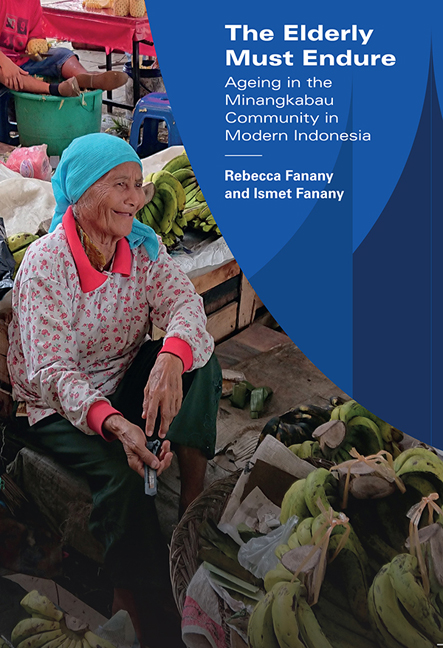Book contents
- Frontmatter
- Contents
- Acknowledgements
- Map of Indonesia
- Map of West Sumatra
- Map of the Village of Koto
- Aminah's Family Tree
- 1 Introduction
- 2 Ageing in the Past and Present
- 3 Adat Traditions and the Elderly
- 4 Religion and the Elderly
- 5 Language and the Elderly
- 6 Ageing in the Village
- 7 Ageing in Padang
- 8 Ageing in the Rantau
- 9 Ageing in an Institution
- 10 Ageing and Cultural Consonance
- 11 The Elderly Must Endure
- Afterword
- References
- Index
- About the Authors
4 - Religion and the Elderly
Published online by Cambridge University Press: 16 May 2019
- Frontmatter
- Contents
- Acknowledgements
- Map of Indonesia
- Map of West Sumatra
- Map of the Village of Koto
- Aminah's Family Tree
- 1 Introduction
- 2 Ageing in the Past and Present
- 3 Adat Traditions and the Elderly
- 4 Religion and the Elderly
- 5 Language and the Elderly
- 6 Ageing in the Village
- 7 Ageing in Padang
- 8 Ageing in the Rantau
- 9 Ageing in an Institution
- 10 Ageing and Cultural Consonance
- 11 The Elderly Must Endure
- Afterword
- References
- Index
- About the Authors
Summary
RELIGION IN THE MINANGKABAU COMMUNITY
All Minangkabau are Muslim, and identification with this religion is part of the ethnic identity of the group. For this reason, it is not possible for members of the ethnic group to profess another religion; if they do convert, for example, they effectively remove themselves from the rest of the community. There have been one or two cases of a family member of a prominent Minangkabau figure converting to Christianity which, when known to the public, immediately became a major topic of discussion among the public, and this is increasingly a topic of discussion in Minang language social media. One such case involved the half-brother of Hamka, a prominent writer and religious leader. A recent biography documents this and other aspects of the life of this half-brother, which some readers consider despicable and have linked with the recurrent issue of a missionary presence in West Sumatra. It is unclear to what extent Christian missionaries have actually approached members of the Minangkabau community in the past, but there have been several conspiracy-type accusations that circulated among the public in recent years (see, for example, Minang Lamo 2013). Anecdotal evidence suggests that conversions from Islam rarely occur. However, religion is a central element of identity perception among the Minangkabau and one whose practices frame its experience. In this, the experience of the community parallels that of several other groups in the Malay world, most notably the Malay themselves, for whom adherence to Islam is a fundamental characteristic that determines ethnic identification (Lian 2001).
For the Minangkabau, as is the case for many of Indonesia's ethnic groups, Islam represents a comparatively new influence in their history. Islam is viewed as having reached Indonesia in the eleventh century (Ricklefs 2008), likely introduced by traders and travellers from India and the Middle East. The religion gradually spread, replacing the older Hindu and Buddhist practices that were already in existence (Clarke et al. 2004). These older practices, which had long since entered the region from India, had mixed with indigenous religious beliefs that are thought to have had a strong supernatural dimension (Brakel 2004). The original religious practices of Indonesia never completely disappeared however, and it is not uncommon to see traces of them in modern society.
- Type
- Chapter
- Information
- The Elderly Must EndureAgeing in the Minangkabau Community in Modern Indonesia, pp. 75 - 94Publisher: ISEAS–Yusof Ishak InstitutePrint publication year: 2018



